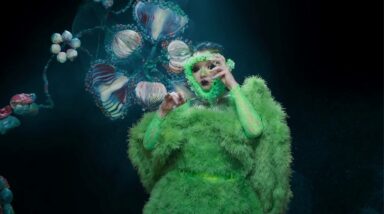Eunice Tsang, founder and curator of Current Plans – an off- space in Hong Kong dedicated to site-specific installations and experimental art – engages in a dialogue with Tomihiro Kono, the visionary hair artist from Japan
Curated by DOMENICO COSTANTINI
I first set eyes on Tomihiro’s wigs two and a half years ago, when I was setting up a new off-space called Current Plans in Hong Kong. The space, a revamped old fabric storage, was situated in a grassroots area in which there were plenty of eclectic hair salons, most of them operated by middle-aged aunties sporting funky hairstyles, like living fossils from the 2000s. Living in the neighbourhood, I frequented one called “Hair Art Family”, a rather shabby shop just below my home. Lisa, hailing from mainland China, was one of the most energetic, kind-hearted stylist with whom I ventured into a series of (sometimes regrettable) perms, straighten- ings, bleaches, highlights, eye-blinding colourings and so on. When I saw Tomihiro’s outrageously colourful and ex- perimental wigs, it instantly resonated. The extravagance of Tomihiro’s wigs have an immediacy to them – a visceral response that is an appreciation of skill and craftsmanship, a universal language that humans have a gut feeling for, no matter their context. Encompassing all areas from contemporary art (the wigs can be read as soft sculptures), fashion, design, craft, Tomihiro’s vision of hair echoed, or rather expanded, my own vision of how I wanted to run my off-space – fluid, generous, meticulous and most of all, experimental. During the two years worth of exchang- es, in preparation of our exhibition Fancy Creatures – The Art of Wig Making, Tomihiro, his longtime partner Sayaka, and I found a mutual affinity for zoology, artificial land- scapes, and gardening (They’re into rare orchids while I’m into tropical plants). Hence, for the exhibition design we opted to get rid of mannequins or anything related to the human shape. The wigs would have lives of their own, float- ing in the art space like jellyfish around an artificial rocky mountain, reminiscent of an aquatic diorama that visitors could explore. In the exhibition Fancy Creatures – The Art of Wig Making, 20 fancy wigs and numerous smaller braids and finger wave accessories are on show. We are very lucky to have a few that were made for Björk recently, for whom Tomihiro de- signed almost 100 wigs inspired by various underwater crea- tures and fungi. The basis for each of these wigs is the “fin- ger wave”, an iconic hairstyle from the 1920s Golden Age, in which strands of hair were meticulously set into a wavy “S” shape. Putting a contemporary twist on Old Hollywood glamour, Tomihiro weaves his magic into organic forms that mimics reptilian tails, snake heads, tarantula eyes, rainfor- est frogs and more, which ultimately creates his inimitable avant-garde aesthetic.

Can you tell us about your early beginnings?
I grew up in Ehime, a rural prefecture in the northwest of Shikoku Island, famous for its satsuma (mandarins). I was living in the countryside at my parents’ farm, and I started to yearn for urban life. Back then, Tokyo’s Harajuku’s street culture was mainstream. I got so much inspiration from it that my dream was to work there one day. As I loved animals, my mum told me that I should start with humans first (before being a hairdresser for pets). So, I followed her advice and started working at a hair styling salon in Harajuku.
How did you go from being a hairdresser to wig-maker?
After some years as a hairdresser in Tokyo where I learnt all the basics, I went to London in 2007 and started as a session stylist, working specifically with fashion magazines and shows. Later, i moved to New York, and delved into wig-making. It’s a craft that has existed for centuries and I tried to learn it all from scratch all by myself. I would order wigs from eBay and teach myself by watching YouTube videos.
So the big question is… how do you make your wigs?
A wig starts with a base made of mesh lace, with which I knot individual strands of hair into the using a wig-ventilating-needle. Sometimes the hair extensions are al- ready coloured, sometimes they are hand painted after stitching them. Once the wig is made, I start to think about the style and character. When I create head props, I use any materials I find inspiring, like glass beads. I try to make the head props as light as possible, because that’s more comfortable.

You always represent men inside forests, but is there any boundary between humans and nature?
It was us poor humans who invented the concept of nature: when we invent something, it is because we are afraid of it and want to take something away from it. But man and nature are the same thing. We are inside nature, and nature is everywhere, even in your room. Actually, when you do anything, even when you pee, you are giv- ing something to nature. So it is important to understand the way to live, because na- ture is not against us. “We, as human beings, are all the same, but each of us has a unique personality and a transformative identity.
My wigs are artefacts to encourage and foster a continuous transformation.”
People are surprised when they enter the exhibition, especially when they realise it’s real human hair. Why do you think hair holds power? I think hair is always powerful when it belongs to a human (or an animal), but when it is a separate object, it is such a powerful material. You can keep hair in good condition for such a long time, and there isn’t anything else like its warmth and texture. It’s like living history, a treasure.

Lately it seems there is a constant search for combining nature and technology..
I think we must be elegant and very accurate with technology every time. High technology is a possibility that could work, but for me is not yet enough. When they realise a technology, they say it should improve by time, but actually it changes just a little bit and never becomes better as expected. On the contrary, biotechnology is more important for me.
One of the paintings in my exhibition is about a grain of sand that gives troubles to a machine, and destroys it. This is the power of the future: we can put our energy and our life just into a grain of sand and change things. This is technology, too, as well as a knife.
Wigs are a niche but also unmistakable part of the fashion industry. What position do you think your fancy wigs have?
At the beginning of my career, I was simply happy to make a hairstyle for a photo shoot or editorial. But then I started questioning how a life of hairstyle can be extended longer than just a one off usage. I started making wigs for mainly 3 reasons. First, I can change the model’s character completely. If the model has black hair, I can instantly change it into any other colour with a wig, avoiding damage to their real hair. Second, the wig can be used again and again. I can upgrade them by recolouring or changing hairstyles (cutting or curling). I can keep them all my life if I want to. And third, the wig can be exhibited in a gallery without models. At some point, I noticed a fourth option, that I can work with international clients remotely. If my wig has a musician as its owner, I hope it will enjoy gigs along with them.
I understand that making wigs take up a huge amount of time and concentration. What do you do for relaxation?
I have a garden in my backyard that I enjoy spending time in. I maintain my plants and feed my fish. I enjoy touching and watering the plants as well as planting some herbs. I love focusing on nature when I’m not in the mood for working. It’s really relaxing.



